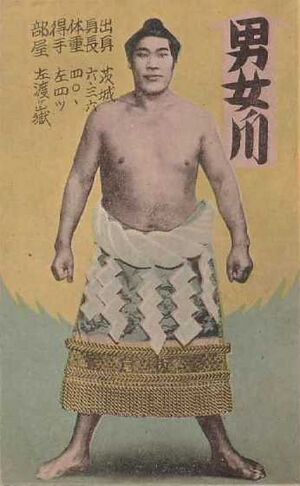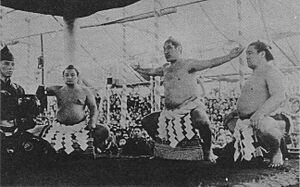Minanogawa Tōzō facts for kids
Quick facts for kids Minanogawa Tōzō |
|
|---|---|
| 男女ノ川 登三 | |

Script error: The function "getImageLegend" does not exist.
|
|
| Personal information | |
| Born | Sakata Tomojiro September 17, 1903 Ibaraki, Japan |
| Died | January 20, 1971 (aged 67) |
| Height | 1.91 m (6 ft 3 in) |
| Weight | 146 kg (322 lb) |
| Career | |
| Stable | Takasago, Sadogatake |
| Record | 294-155-34-1draw |
| Debut | January 1924 |
| Highest rank | Yokozuna (January 1936) |
| Retired | January 1942 |
| Elder name | Minanogawa |
| Championships | 2 (Makuuchi) 1 (Sandanme) |
| Gold Stars | 2 (Tsunenohana, Tamanishiki) |
| * Up to date as of June 2020. | |
Minanogawa Tōzō (Japanese: 男女ノ川 登三, September 17, 1903 – January 20, 1971), also known as Asashio Kyojiro (朝潮 供次郎), was a Japanese professional sumo wrestler. He came from Tsukuba, Ibaraki. He became the 34th yokozuna, which is the highest rank in sumo.
Contents
Minanogawa Tōzō: A Sumo Legend
Minanogawa Tōzō was a very tall and strong sumo wrestler. He reached the top of the sumo world. His journey was full of challenges and exciting moments. He is remembered as one of the great champions of his time.
Early Life and Start in Sumo
Minanogawa was born Sakata Tomojiro. He was born on September 17, 1903. His father died when he was only two years old. He worked hard as a laborer to help his mother. By age 15, he was already 1.82 meters (about 6 feet) tall. This was very tall for a Japanese teenager back then.
A sumo stable (training group) called Takasago stable noticed him. He joined them and began his sumo career in January 1924. He quickly moved up the ranks. After just six tournaments, he reached the second-highest division, called jūryō, in January 1927.
At first, Minanogawa mostly used pushing techniques, known as oshi-sumo. But he learned more moves from a former sekiwake (a high-ranking wrestler) named Kiyosegawa. This helped him become a more complete wrestler.
Rising Through the Ranks
In January 1928, Minanogawa was promoted to the top division, called makuuchi. In 1929, the wrestler who found him, Akutsugawa, retired. Akutsugawa wanted Minanogawa to join his new stable, Sadogatake. But Minanogawa's current stablemaster, Asashio Tarō II, wanted him to stay. He even changed Minanogawa's wrestling name (shikona) to Asashio to keep him.
Eventually, they found a solution. Minanogawa split his time between both stables. He became a komusubi (a high rank) in January 1930. He finished second in two tournaments in a row. This happened in October 1930 and January 1931. He was very popular, along with another wrestler named Musashiyama.
However, Minanogawa faced some tough times. In 1931, he hurt his knees many times. In 1932, he was part of the Shunjuen Incident. This was when many top sumo wrestlers went on strike. Minanogawa left the Japan Sumo Association for four tournaments. During this time, he and other wrestlers held their own sumo events.
Becoming a Yokozuna
Minanogawa returned to the Sumo Association in 1933. He immediately won his first tournament championship. He did not lose a single match! He beat other strong wrestlers who had stayed with the Association during the strike. He went back to using his Minanogawa wrestling name.
He won his second championship in January 1934. This win earned him a promotion to ōzeki, the second-highest rank. He was promoted to yokozuna in January 1936. This happened after he finished second in a tournament with a 9–2 record. He became yokozuna just one tournament after Musashiyama. Some people thought it was a special agreement between the sumo groups.
Even though he was a yokozuna, Minanogawa did not win any more championships. He was often overshadowed by other great yokozuna like Tamanishiki and Futabayama. He could not beat Futabayama as a yokozuna. He only beat Tamanishiki once. In May 1938, he won only six out of 13 matches. This was a rare losing record (make-koshi) for a yokozuna.
By 1941, Minanogawa was 36 years old and had many injuries. He wanted to retire. But he was asked to keep wrestling until other strong wrestlers were ready to take his place. He finally retired in January 1942.
Life After Sumo

After retiring, Minanogawa could have stayed in sumo as an elder (a sumo official). But he had lost interest in sumo. He had recently gotten married and started a family. He also studied law and economics at Waseda University.
He decided to leave the Sumo Association. This was a big decision because it meant he could never return. He wanted to run for election to parliament. However, he lost the election badly. He also lost most of the money he received from the Sumo Association. He tried many different jobs, but none of them worked out well. He even had a small role in a 1958 Hollywood movie called The Barbarian and the Geisha.
Later in his life, he separated from his wife and children. In his final years, he needed care in a rest home. He relied on help from fans and sumo officials. Minanogawa Tōzō died in 1971. By then, many people had forgotten about him.
See also
- Glossary of sumo terms
- List of past sumo wrestlers
- List of sumo tournament top division champions
- List of yokozuna

